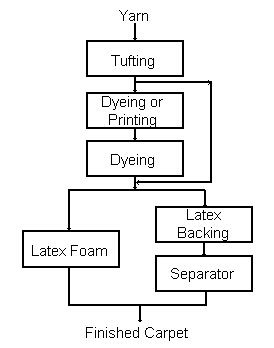Carpet mills form a distinct part of the industry although their effluents are similar in many ways to those of the knit fabric finishing mill. Figure 8 shows the various process details of a Carpet Manufacture Mill.
Carpet mills use mostly synthetic fibres (nylon, acrylic and polyesters), but some wool and cotton are also processed. This category is characterized by any or all of the following operational units: bleaching, scouring, carbonizing, dyeing, printing resin treatment, water proofing, flame proofing, soil repellency, backing with foamed and unfoamed latex or jute. Carpet backing without other carpet manufacturing operation may be included in the dry processing mill category. Some carpet is backed with latex in a separate plant. Other carpet mills do latexing in the same plant with the finishing. Tufted carpets consist of face yarn that is looped through a woven mat backing (mostly polypropylene, some jute), dyed or printed, and then backed with either latex foam or coated with latex and a burlap-type woven fabric backing put over the latex.
The dominant face yarn is nylon, followed by acrylic, modacrylic and polyester. The latter two groups taken together are about equal to nylon. Since dyeing of these fibres in carpets differs little from dyeing fabric, the dyeing descriptions for these fibres given in other categories applies here as well.
The yarn is tufted into a woven or synthetic non-woven polypropylene or jute primary backing in a dry operation. Following this, the tufted carpet can be either printed or dyed. If printed, a semicontinuous screen printing operation is performed, followed by a wash and rinse step in the same machine. If dyed, the most common method is beck dyeing, in a manner quite similar to that described in previous categories for yarn goods. The continuous dyeing appears very similar to the continuous pad stream process used for cotton/synthetic blend broad woven finishing. After it is dyed, the carpet is dried in a tunnel drier. The carpet is then ready for application of adhesive and secondary backing [10].
